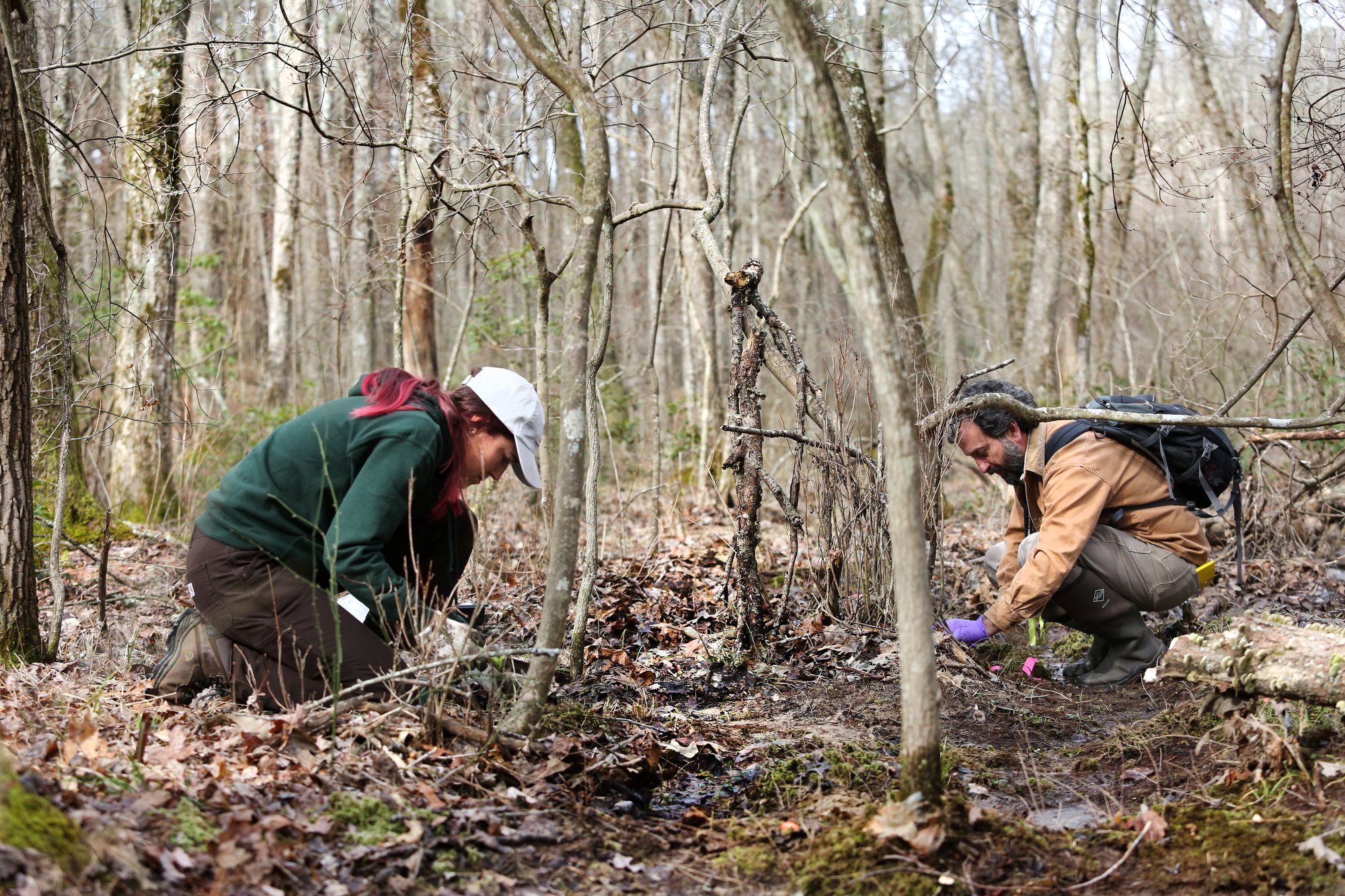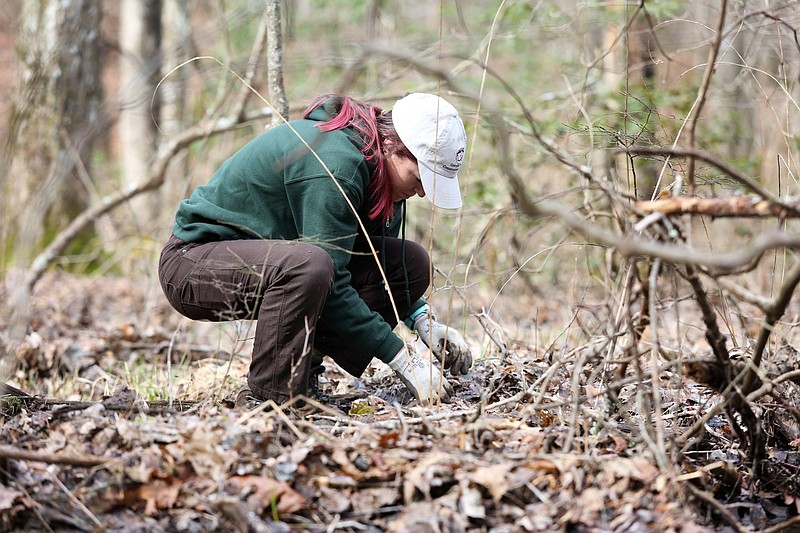 Emma Neigel, a conservation horticulturist at the Atlanta Botanical Garden in Gainesville, Georgia, plants federally threatened white fringeless orchids Tuesday, March 12, 2019 in Virgin Falls State Natural Area in Sparta, Tennessee. A new United Nations report found biodiversity is declining faster now than at any time in human history.
Emma Neigel, a conservation horticulturist at the Atlanta Botanical Garden in Gainesville, Georgia, plants federally threatened white fringeless orchids Tuesday, March 12, 2019 in Virgin Falls State Natural Area in Sparta, Tennessee. A new United Nations report found biodiversity is declining faster now than at any time in human history.Biodiversity is declining faster than at any time in human history as one million species now face extinction due largely to human activity, according to a landmark study by the United Nations.
The report goes further to dramatically link human actions to species collapse than previous studies as it starkly concludes poor land practices and other man-made problems are directly leading to many species becoming threatened, endangered, and ultimately, at risk of extinction.
"The health of ecosystems on which we and all other species depend is deteriorating more rapidly than ever. We are eroding the very foundations of our economies, livelihoods, food security, health and quality of life worldwide," according to a prepared statement from group chairman Robert Watson.
Human actions threaten more species with global extinction than ever before with an average of 25 percent of species assessed being threatened and facing extinction - many within decades unless action is taken, according to the report.
The report was compiled by 145 experts from 50 countries over three years with input from 310 additional scientists. The study was based on a review of 15,000 scientific and government sources as well as interviews with indigenous and local people about their areas.
What does this mean for the Southeast?
There are 101 federally-listed species found in Tennessee, 78 in Georgia and 132 in Alabama, according to U.S. Fish & Wildlife data - all threatened or endangered, many due to human impacts.
Among them are gray bats, Laurel dace, white fringeless orchid and the trispot darter.
"A lot of people think extinction is just in the rainforest and other areas, but it's going on in our own backyard," said Tennessee Aquarium Conservation Institute science program manager Bernie Kuhajda.
Land-use changes have had the largest impact on the declining biological diversity worldwide, especially on terrestrial and freshwater ecosystems, according to the report. Changes have been driven primarily by agriculture, forestry and urbanization causing air, water and soil pollution.
The Southeast boasts the most freshwater biodiversity for a temperate climate anywhere in the world. However, species are threatened, and a lack of funding compared to the rest of the U.S. leaves little room for restoration efforts. Fish like Alabama's cahaba shiner and Southeast Tennessee's amber darter need more money for protection, biologists argue. Land practices are threatening their habitats.
Non-native species are suffocating ecosystems. Invasive carp are heading toward Chattanooga after having decimated waterways in the Midwest. The fish were brought to the southern U.S. from Southeast Asia in the 1970s to help clean retention ponds, but the plan backfired when the fish escaped into the Mississippi River system during flooding and migrated to the Missouri and Illinois rivers.
Invasive plants like Kudzu have long tormented the Southeast, choking native species. The plant was brought to the U.S. from Asia by humans and marketed and distributed across the South through the late-19th and early-20th centuries. It has grown rapidly, occupying roughly a quarter of a million acres in the U.S.
The natural collapse has been accelerating globally in the past 50 years due to changes in land and sea use, direct exploitation of organisms, climate change, pollution and the invasion of non-native species, according to the report. In that same time period, the human population has doubled, the global economy has grown four-fold and global trade 10-fold, according to the report.
Populations of native species have fallen on average by at least 20% since 1900 with more than 40% of amphibian species, 33% of coral reefs and more than a third of all mammals being threatened.
Those changes have driven up demands for energy and material goods at the expense of conservation and restoration. Seventy-five percent of the land surface has been significantly altered with large swaths of oceans and wetlands harmed, according to the report.
"While more food, energy and materials than ever before are now being supplied to people in most places, this is increasingly at the expense of nature's ability to provide such contributions in the future and frequently undermine nature's many other contributions, which range from water quality regulation to sense of place," according to the report's summary.
The tropics are projected to be the most heavily impacted as biodiversity loss accelerates through 2050, unless drastic actions are taken, according to the report. The areas of the world with the largest concentrations of indigenous people and many of the world's poorest communities are projected to experience significant negative effects from the changes.
Nature is essential for human existence and good quality of life, according to the report. Most of its contributions aren't fully replaceable, and some are irreplaceable, it reads.
It provides food, energy, medicine, genetic resources and other materials necessary for life. It also is instrumental in water quality and adds to one's sense of place, according to the report.
"Nature, through its ecological and evolutionary processes, sustains the quality of the air, fresh water and soils on which humanity depends," the report reads. "[It also] distributes fresh water, regulates the climate, provides pollination and pest control and reduces the impact of natural hazards."
What can be done?
Conservation and sustainability goals can't be met based on current trends, according to the report.
Global conservation efforts like the Aichi Biodiversity Targets and the 2030 Agenda for Sustainable Development won't be achieved without additional intervention. The current trajectories undermine other goals like the Paris Agreement.
However, that doesn't mean it's too late to avoid a biological collapse, according to the report's authors.
"Societal goals can be achieved in sustainable pathways through the rapid and improved deployment of existing policy instruments and new initiatives that more effectively enlist individual and collective action for transformative change," the report reads.
The report lists five main steps countries can take to change the current trajectory: incentives; cooperation; preemptive action; decision-making with resiliency in mind, and environmental law and implementation. Widespread change involves advancing and aligning local, national and international sustainability efforts, according to the report.
Locally, everyone can take small steps, Kuhajda said.
He recommended residents be smarter about maintaining their yards by limiting herbicide and pesticide use and the over-reliance on sprinkler systems. Other steps like not using bug zappers to kill mosquitoes can be helpful as the devices kill other insects necessary for pollination. Other steps include planting native plants rather than exotic plants found commonly at area nurseries and reducing the use of single-use plastics.
Chattanooga Mayor Andy Berke pledged to make Chattanooga a more resilient community in his 2019 State of the City address. He announced the formation of a regional resiliency council of mayors and commissioners in Southeast Tennessee and Northwest Georgia. The group will formulate plans and policies to make cities more resilient to the changing climate, as Berke believes the Chattanooga area could be a beacon for cities wanting to combat the issue. Hamilton County leaders are looking at safer development practices as part of the county's emergency mitigation plan.
The Association of Zoos and Aquariums (AZA) is already taking action. It's accredited facilities, including the Chattanooga Zoo and Tennessee Aquarium, contributed $220 million to conservation efforts in 2017 and educated nearly 200 million guests. The zoo has several ongoing conservation initiatives while the aquarium also encourages local businesses and citizens to limit plastic waste.
"The conclusions in the United Nations' IPBES Global Assessment are alarming," according to a statement from AZA President and CEO Dan Ashe. "This conclusion, backed by a three-year study, is profoundly troubling news. AZA-accredited facilities are taking action to help save species and their habitat and invite the public to join us."
Contact staff writer Mark Pace at mpace@timesfreepress.com or 423-757-6659. Follow him on Twitter @themarkpace and on Facebook at ChattanoogaOutdoorsTFP.
